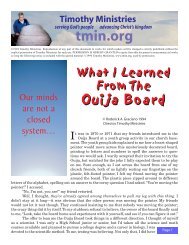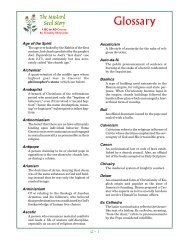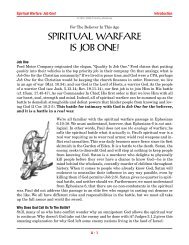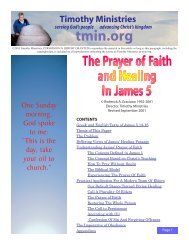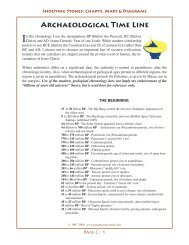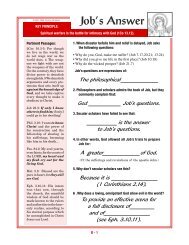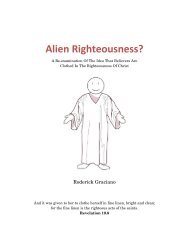Making The Invisible Visible Section 4
Making The Invisible Visible Section 4
Making The Invisible Visible Section 4
Create successful ePaper yourself
Turn your PDF publications into a flip-book with our unique Google optimized e-Paper software.
Hermeneutics: <strong>Making</strong> <strong>The</strong> <strong>Invisible</strong> <strong>Visible</strong> — © 2004 Roderick Graciano<br />
that speaks powerfully to the mind of anyone who ever saw<br />
a hen or a goose gather her chicks or goslings under her wing<br />
at the approach of a predator.<br />
We westerners struggle, however, with some of the Bible’s<br />
character metaphors, because we have trouble looking past<br />
the thing pictured (wing) to its function (protection). We must<br />
not forget the Hebraic action+function orientation. Take for<br />
example the description of the Shulammite’s nose in Song of<br />
Solomon:<br />
Your nose is like the tower of Lebanon looking toward Damascus. (Song 7.4)<br />
At first glance, we don’t even realize that this description<br />
speaks of an inner quality. To us this line of the poem looks like<br />
a straightforward physical description, and frankly, it seems<br />
a rude one. Upon reflection we begin to wonder if possibly the Israelites of antiquity<br />
thought large noses were beautiful. However, we are barking up the wrong tree. We<br />
must think of the function of a tower in ancient Israel, to understand what the poet is<br />
describing. When we remember the Hebrew emphases on both character and function<br />
we can begin to understand the point of the Shulammite’s nose (pun intended). Comparing<br />
her nose to a tower, compellingly describes the Shulammite’s “insurmountability,<br />
inaccessibility, pride, purity, and virginity.” Thorlief Boman explains how all of these<br />
qualities are expressed in the tower metaphor applied to the maiden’s nose (Song 7.4),<br />
neck (4.4; 7.4) and breast (8.10). 4 What the poet praised was the Shulammite’s inner<br />
character and personal discipline, using her external traits and bearing as metaphors.<br />
If we miss this translation of invisible qualities into concrete and dynamic metaphors,<br />
we miss both the meaning and the power of the text.<br />
<strong>The</strong> Danger of Vivid Language<br />
<strong>The</strong> dynamic metaphors of Hebrew can bring God’s message vividly to life for us, but<br />
they also present us westerners with two dangers. First, we can fail to recognize them<br />
as metaphors and take them literally. A naïve reading of the Old Testament could mislead<br />
us into thinking that God is an avian being with actual (if invisible) wings (Psalm<br />
57.1). A more experienced reader will recognize such descriptions as metaphorical, but<br />
may still succumb to the second danger, which is the failure to recognize character<br />
metaphors as describing inner rather than outer qualities. We are apt to stumble over<br />
the metaphor of the Shulammite’s tower-like nose, discussed above, or the description<br />
of the Shulammite’s sister as a “wall” or a “door” in Song 8.9. Similarly, when we<br />
read Psalm 52.8, “I am like an olive tree flourishing in the house of God,” we probably<br />
visualize the Psalmist standing still in the temple, experiencing a static, column-like<br />
existence. To properly understand these passages, however, we must focus on the function<br />
of a door, the function of a wall, the function of an olive tree. 5 We will avoid the<br />
dangers of Hebraic metaphors if we will keep ever before us the twin Hebraic emphases<br />
on character and dynamic function.<br />
Page 5





